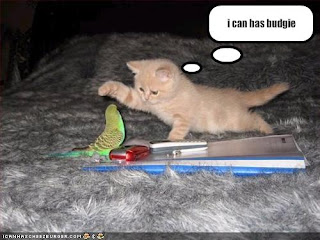Do you want to be your budgie's friend? Do you want to be there for him, comfort him and gain his trust, so he can be sure that he is in safe hands?
I suppose the answer is yes, otherwise you wouldn't decide on buying a budgerigar.
Some people like to clip their budgie's wings. Their main reasons are so that the budgie can't escape or hurt itself while flying in the room. There are also stories of budgies with an "agressive" behaviour that get a lot calmer after their wings are trimmed. Some other people just like to clip their budgie's wings because they want their budgies to be tame. That's the "easy way", you know.

My answer to this is very simple: you can avoid all this trouble without even touching their wings.
Budgies are airborne creatures that need to fly around every day. But you can't let them escape out into the wilderness where they will only perish. So you must let them do it indoors.
Here you can find a checklist to make sure the rooms are clear of hazards when your budgie wants to fly around inside. Don't come up with lousy excuses like "I don't want my budgie to get hurt so I have to keep him in the cage", just clear a safe path for him.
If you don't allow your budgie to fly around freely, you're not suited to be a budgie owner.
If you have an "aggressive" budgie, don't just brutally clip his/her wings but try to get to the
source of the problem. The budgie may be stressed, or jealous (e.g. when you're keeping two females and one male). Or maybe they're living in a space that is too small? After you find out what the problem is, get to the
solution. Remove the element that causes the budgie to be stressed (this could be an annoying noise like a barking dog, the rattling of a child toy, the buzzing of a lawn mower) or just move your budgie to a quiet room. In the case of jealousity, you can temporarily keep the two females apart until they both calmed down. Of course, when you clip their wings, they calm down because they're too scared to make a wrong manoeuvre and fall down without being able to fly back up again. Wouldn't you be?
Besides, there are very few to no conflicts between budgerigars. They love playing and they might go as far as playfighting, but they would never injure each other. When it comes to breeding, they might be a bit more aggressive. But then again, it usually doesn't go any further than a single peck that serves as a warning.
If you want to tame your budgie, you have to do it kindly. Clipping their wings is not kind at all. There's not only a high risk of hurting them, but you're also horrifying your budgie while you are doing it. For the rest of your life, he will regard you as the monster who stole his wings so that he cannot be a real budgerigar anymore. Real budgerigars need to fly.
With doing it kindly, I mean that you have to gain his trust. Whisper soft words to him, feed him little tidbits of food, just talk to him and tell him you're there for him and care about him. After a while, he will come to you automatically and offer you his friendship in return for your kindness.
Do you want to know why I'm writing this? Today, my mum bought a young dark green budgie in the local pet store. The little budgie is not even eight months old. When I saw him, I immediately saw the horrible thing they had done with his right wing. His breeder has cut HALF of his wing off. It looked so ugly that I was amazed that the budgie had survived it. If you still want to have your budgie's wings trimmed - consider all of the above facts first. The budgie that my mum brought in today is not able to fly and flutters around like a drunk hurricane. This can be just as dangerous as letting a budgie fly around in the room - and much harder to avoid accidents.


















































